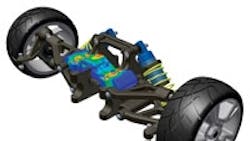The Mercedes Car Group claimed an industry first earlier this year when it introduced its 2008 C-Class as "the world's first series-production vehicle" conceived and fully developed as a digital prototype. The technology allowed the car maker to perform a wealth of analyses on the Mercedes-Benz C-Class well before any physical prototypes were constructed.
Indeed, the ability to not only visualize product development in 3-D but also to simulate how that product would perform in the physical world are among the benefits assigned to digital prototyping. Research from consulting firm Aberdeen Group, in fact, shows that the use of digital prototypes results in fewer physical prototypes for top-performing companies, which both reduces their product development costs and speeds up how quickly products get to market.
The efficiencies associated with digital prototyping are not lost on Gulf Stream Coach Inc., a privately held manufacturer of recreational vehicles. With more than 10 years of lean manufacturing management under its belt, Gulf Stream Coach is all about removing waste, gaining efficiency and reacting quickly to changing market conditions. It also means that continuously working to improve its processes is a given.
Already a longtime user of Autodesk Inc.'s 2-D solutions, Gulf Stream Coach recently purchased the software company's 3-D Inventor software to help streamline the information cycle time, as well as to reduce the need for physical prototypes. Additionally, the purchase allows the company to retain access to its legacy database of 2-D prints.
Mike Potis, head of Gulf Stream Coach's product development group, expects digital prototyping to improve communication between all parties. "The mind is not always able to convert a 2-D drawing to a 3-D world," he says. "A 2-D environment is more open to interpretation."
See Also
About the Author
Jill Jusko
Bio: Jill Jusko is executive editor for IndustryWeek. She has been writing about manufacturing operations leadership for more than 20 years. Her coverage spotlights companies that are in pursuit of world-class results in quality, productivity, cost and other benchmarks by implementing the latest continuous improvement and lean/Six-Sigma strategies. Jill also coordinates IndustryWeek’s Best Plants Awards Program, which annually salutes the leading manufacturing facilities in North America.
Have a story idea? Send it to [email protected].

